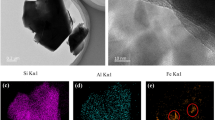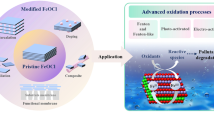Abstract
In situ degradation of organic contaminants by Pd and electro-generated H2 and O2 overcomes the drawbacks to traditional Fenton process, and conducting heterogeneous catalyst of FeMgAl layered double hydrotalcite (LDH) further improved the efficiency and stability. Using bisphenol A (BPA) as the model contaminants, 90% removal can be achieved with 1200 mg/L Pd/Al2O3 and FeMgAl-2. The reusability was satisfying due to the very limited leaching of Fe ions at 0.1 ppm level. FeMgAl also amplified the window of pH for Pd-catalyzed in situ advanced oxidation processes (AOPs) from 3 by homogenous Fe(II) to 3–7 by FeMgAl LDH. The COD of landfill leachate effluent of the MBR system removed by about 52.3% by this system by the initial pH was 5. Characterizations revealed the distinguishing features associated with LDH structure such as large surface area, good stability, basic character, and strong linage among active sites were accounted for the remarkable performances over a wide pH window. Five reactive intermediates were observed and multiple degradation pathways were proposed in Pd-catalyzed in situ AOP for the first time. Interestingly, because of the unique role of Pd catalyst, these degradation pathways were clearly distinguished from traditional Fenton or Fenton-like AOPs and may provide a new approach of in situ heterogeneous AOPs for refractory contaminants in future.








Similar content being viewed by others
References
Abu Amr SS, Aziz HA (2012) New treatment of stabilized leachate by ozone/Fenton in the advanced oxidation process. Waste Manag 32(9):1693–1698
Benselka-Hadj Abdelkader N, Bentouami A, Derriche Z, Bettahar N, De Ménorval LC (2011) Synthesis and characterization of Mg–Fe layer double hydroxides and its application on adsorption of orange g from aqueous solution. Chem Eng J 169(1–3):231–238
Bokare AD, Choi W (2014) Review of iron-free Fenton-like systems for activating h2o2 in advanced oxidation processes. J Hazard Mater 275:121–135
Cavani F, Trifirò F, Vaccari A (1991) Hydrotalcite-type anionic clays: preparation, properties and applications. Catal Today 11(2):173–301
Chen D, Kannan K, Tan H, Zheng Z, Feng YL, Wu Y, Widelka M (2016) Bisphenol analogues other than bpa: environmental occurrence, human exposure, and toxicity-a review. Environ Sci Technol 50(11):5438–5453
Choi H, Al-Abed SR, Dionysiou DD, Stathatos E, Lianos P (2010) Chapter 8 TiO2-based advanced oxidation nanotechnologies for water purification and reuse. Sustainability Science and Engineering 229–254
Choudhary VR, Gaikwad AG, Sansare SD (2002) Activation of supported pd metal catalysts for selective oxidation of hydrogen to hydrogen peroxide. Catal Lett 83(3):235–239
Choudhary VR, Samanta C, Jana P (2007) Decomposition and/or hydrogenation of hydrogen peroxide over pd/al2o3 catalyst in aqueous medium: factors affecting the rate of h2o2 destruction in presence of hydrogen. Appl Catal A Gen 332(1):70–78
Esplugas S, Bila DM, Krause LG, Dezotti M (2007) Ozonation and advanced oxidation technologies to remove endocrine disrupting chemicals (edcs) and pharmaceuticals and personal care products (ppcps) in water effluents. J Hazard Mater 149(3):631–642
Fan G, Li F, Evans DG, Duan X (2014) Catalytic applications of layered double hydroxides: recent advances and perspectives. Chem Soc Rev 43(20):7040–7066
Gao Y, Zhang Z, Li S, Liu J, Yao L, Li Y, Zhang H (2016) Insights into the mechanism of heterogeneous activation of persulfate with a clay/iron-based catalyst under visible led light irradiation. Appl Catal B Environ 185:22–30
Goh KH, Lim TT, Dong Z (2008) Application of layered double hydroxides for removal of oxyanions: a review. Water Res 42(6–7):1343–1368
Guan YH, Ma J, Li XC, Fang JY, Chen LW (2011) Influence of ph on the formation of sulfate and hydroxyl radicals in the uv/peroxymonosulfate system. Environ Sci Technol 45(21):9308–9314
Hsueh CL, Huang YH, Wang CC, Chen CY (2005) Degradation of azo dyes using low iron concentration of Fenton and Fenton-like system. Chemosphere 58(10):1409–1414
Jawad A, Lu X, Chen Z, Yin G (2014) Degradation of chlorophenols by supported co-mg-al layered double hydrotalcite with bicarbonate activated hydrogen peroxide. J Phys Chem A 118(43):10028–10035
Jawad A, Li Y, Lu X, Chen Z, Liu W, Yin G (2015) Controlled leaching with prolonged activity for co-ldh supported catalyst during treatment of organic dyes using bicarbonate activation of hydrogen peroxide. J Hazard Mater 289:165–173
Jawad A, Li Y, Guo L, Khan A, Chen Z, Wang J, Yang J, Liu W, Yin G (2016) Bimetallic synergistic degradation of chlorophenols by cucoox–ldh catalyst in bicarbonate-activated hydrogen peroxide system. RSC Adv 6(76):72643–72653
Jin F, Al-Tabbaa A (2014) Evaluation of novel reactive mgo activated slag binder for the immobilisation of lead and zinc. Chemosphere 117:285–294
Kim K, Qiu P, Cui M, Khim J (2016) Development and application of fe3o4–pd nanospheres as catalyst for electrochemical-heterogeneous Fenton process. Chem Eng J 284:1165–1173
Kishore D, Rodrigues AE (2008) Liquid phase catalytic oxidation of isophorone with tert-butylhydroperoxide over Cu/Co/Fe–mgal ternary hydrotalcites. Appl Catal A Gen 345(1):104–111
Kloprogge JT, Hickey L, Frost RL (2004) Ft-Raman and FT-IR spectroscopic study of synthetic Mg/Zn/Al-hydrotalcites. J Raman Spectrosc 35(11):967–974
Koilraj P, Srinivasan K (2013) Znal layered double hydroxides as potential molybdate sorbents and valorize the exchanged sorbent for catalytic wet peroxide oxidation of phenol. Ind Eng Chem Res 52(22):7373–7381
Lei Y, Chen CS, Tu YJ, Huang YH, Zhang H (2015) Heterogeneous degradation of organic pollutants by persulfate activated by cuo-fe3o4: mechanism, stability, and effects of ph and bicarbonate ions. Environ Sci Technol 49(11):6838–6845
Li J, Ai Z, Zhang L (2009) Design of a neutral electro-Fenton system with fe@fe(2)o(3)/acf composite cathode for wastewater treatment. J Hazard Mater 164(1):18–25
Li W, Wu P-X, Zhu Y, Huang Z-J, Lu Y-H, Li Y-W, Dang Z, Zhu N-W (2015) Catalytic degradation of bisphenol a by comnal mixed metal oxides catalyzed peroxymonosulfate: performance and mechanism. Chem Eng J 279:93–102
Luo M, Yuan S, Tong M, Liao P, Xie W, Xu X (2014) An integrated catalyst of pd supported on magnetic fe3o4 nanoparticles: simultaneous production of h2o2 and fe2+ for efficient electro-Fenton degradation of organic contaminants. Water Res 48:190–199
Ma R, Liu Z, Takada K, Iyi N (2007) Synthesis and exfoliation of co 2+ −fe 3+ layered double hydroxides: an innovative topochemical approach. J Am Chem Soc 129:5257–5263
Mao R, Zhao X, Qu J (2014) Electrochemical reduction of bromate by a pd modified carbon fiber electrode: kinetics and mechanism. Electrochim Acta 132:151–157
Maria Fernandez J, Angeles Ulibarri M, Labajos FM, Rives V (1998) The effect of iron on the crystalline phases formed upon thermal decomposition of Mg-Al-Fe hydrotalcites. J Mater Chem 8(11):2507–2514
Martínez-Huitle CA, Brillas E (2009) Decontamination of wastewaters containing synthetic organic dyes by electrochemical methods: a general review. Appl Catal B Environ 87(3–4):105–145
Matilainen A, Sillanpaa M (2010) Removal of natural organic matter from drinking water by advanced oxidation processes. Chemosphere 80(4):351–365
Matta R, Hanna K, Chiron S (2007) Fenton-like oxidation of 2,4,6-trinitrotoluene using different iron minerals. Sci Total Environ 385(1–3):242–251
Millange F, Walton RI, O'hare D (2000) Time-resolved in situ x-ray diffraction study of the liquid-phase reconstruction of mg–al–carbonate hydrotalcite-like compounds. J Mater Chem 10(7):1713–1720
Mishra M, Chun D-M (2015) Α-Fe2o3 as a photocatalytic material: a review. Appl Catal A Gen 498:126–141
Neyens E, Baeyens J (2003) A review of classic Fenton’s peroxidation as an advanced oxidation technique. J Hazard Mater 98(1–3):33–50
Ozcan A, Oturan MA, Oturan N, Sahin Y (2009) Removal of acid orange 7 from water by electrochemically generated Fenton’s reagent. J Hazard Mater 163(2–3):1213–1220
Park HS, Koduru JR, Choo KH, Lee B (2015) Activated carbons impregnated with iron oxide nanoparticles for enhanced removal of bisphenol a and natural organic matter. J Hazard Mater 286:315–324
Rao YF, Qu L, Yang H, Chu W (2014) Degradation of carbamazepine by fe(ii)-activated persulfate process. J Hazard Mater 268:23–32
Wan Z, Wang J (2017) Degradation of sulfamethazine using fe3o4-mn3o4/reduced graphene oxide hybrid as fenton-like catalyst. J Hazard Mater 324(Pt B):653–664
Xu L, Wang J (2012) Magnetic nanoscaled fe3o4/ceo2 composite as an efficient Fenton-like heterogeneous catalyst for degradation of 4-chlorophenol. Environ Sci Technol 46(18):10145–10153
Xuan S, Chen M, Hao L, Jiang W, Gong X, Hu Y, Chen Z (2008) Preparation and characterization of microsized Feco3, Fe3o4 and Fe2o3 with ellipsoidal morphology. J Magn Magn Mater 320(3–4):164–170
Yu Y, Chen Z, Guo Z, Liao Z, Yang L, Wang J, Chen Z (2015) Removal of refractory contaminants in municipal landfill leachate by hydrogen, oxygen and palladium: a novel approach of hydroxyl radical production. J Hazard Mater 287:349–355
Yuan S, Fan Y, Zhang Y, Tong M, Liao P (2011) Pd-catalytic in situ generation of h2o2 from h2 and o2 produced by water electrolysis for the efficient electro-Fenton degradation of rhodamine b. Environ Sci Technol 45(19):8514–8520
Yuan S, Mao X, Alshawabkeh AN (2012) Efficient degradation of tce in groundwater using pd and electro-generated h2 and o2: a shift in pathway from hydrodechlorination to oxidation in the presence of ferrous ions. Environ Sci Technol 46(6):3398–3405
Zhou L, Hu J, Zhong H, Li X (2012) Study of phenol removal using fluidized-bed Fenton process. Chem Eng Res Des 90(3):377–382
Zhou L, Song W, Chen Z, Yin G (2013) Degradation of organic pollutants in wastewater by bicarbonate-activated hydrogen peroxide with a supported cobalt catalyst. Environ Sci Technol 47(8):3833–3839
Zhou Q, Lei M, Li J, Zhao K, Liu Y (2016) Determination of 1-naphthol and 2-naphthol from environmental waters by magnetic solid phase extraction with Fe@mgal-layered double hydroxides nanoparticles as the adsorbents prior to high performance liquid chromatography. J Chromatogr A 1441(1–7):1–7
Acknowledgments
The authors also thank the Analytical and Testing Center of Huazhong University of Science and Technology for help in XRD, FTIR, SEM, LC/MS/MS and XPS analysis.
Funding
This project was funded by Chutian Scholar Foundation from Hubei province, Shenzhen Science and Technology Development Funds (No. JCYJ20160429182628979), and National Natural Science Foundation of China (No 21671072).
Author information
Authors and Affiliations
Corresponding author
Additional information
Responsible editor: Vítor Pais Vilar
Highlights
• Heterogeneous Fe/Pd-catalyzed in situ AOP overcomes the shortage of traditional Fenton.
• Prepared FeMgAl LDH showed much better performances in both efficiency and stability.
• Degradation pathways including both oxidation and hydrogenation.
Electronic supplementary material
ESM 1
(DOCX 1487 kb)
Rights and permissions
About this article
Cite this article
Liao, Z., Dai, S., Long, S. et al. Pd based in situ AOPs with heterogeneous catalyst of FeMgAl layered double hydrotalcite for the degradation of bisphenol A and landfill leachate through multiple pathways. Environ Sci Pollut Res 25, 35623–35636 (2018). https://doi.org/10.1007/s11356-018-3454-4
Received:
Accepted:
Published:
Issue Date:
DOI: https://doi.org/10.1007/s11356-018-3454-4




